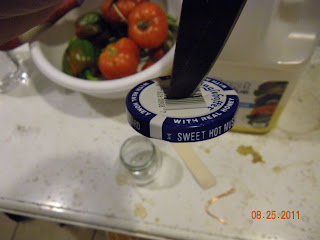Here is my first attempt to cold-process soap. First you need to gather equipment and materials: stainless steel pot, candy thermometer, scale, hand mixer, oils, lye, water, glass bowl, wooden spoon, and molds.

Step 1: measure out oils, lye, and water
Step 2: Heat Oils
Step 3: mix lye with water, be VERY careful, lye is a very dangerous substance and can cause burns, it heats up quickly when added to water. Add lye carefully to water while stirring (I hold my breath to avoid fumes). Set aside to cool.
Step 4: When lye and oils are around the same temperature (around 100 degrees F), slowly mix lye into oil.

Step 5: Stir and keep stirring. I use a hand mixer to speed the process. Mixture will thicken and when you see a "trace" then it is time to add fragrance and pour. A trace is when you pull the spoon out and a dribble will sit on the mixture for a second before sinking in (like a thick pudding).
Pour into molds. Insulate in old blankets or towels.
Allow to set for 24 hours.

After 24 hours, remove from molds and place on cookie cooling racks. Soap must cure for 4-6 weeks before use. During the first week, turn every couple of days, and then once a week thereafter.
I researched soap making for several weeks on the internet to prepare myself for this project. I am pretty impressed with the results. I need to improve on scents. I used flower petals from my garden and essential oil but the soap just smells like soap :)

































